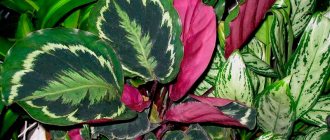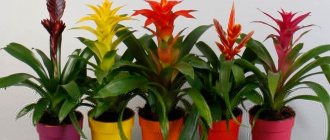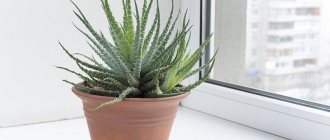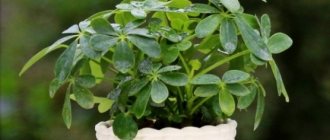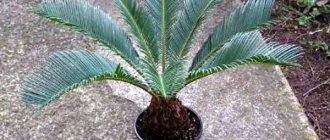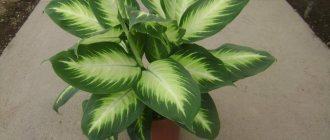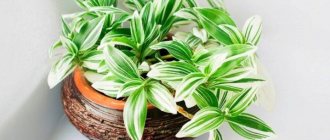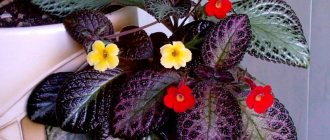Reproduction methods
Why is the yucca flower propagated? Often in order to acquire a new copy of this beautiful plant or give it to someone.
You can also propagate elephant yucca, for example, to plant several plants of different sizes in one pot so that they create a very impressive composition in the form of several tiers of lush greenery.
It should be remembered that the soil for young yucca rooted using one of the methods described below can be made independently from:
- leaf soil (2 parts);
- turf land (2 parts);
- humus (1 part);
- sand (2 parts).
You can also buy ready-made soil in the store. It is important to provide the plant with good drainage at the bottom of the growing container, and also do not forget to add up to 30% coarse sand to the substrate.
Experienced gardeners recommend propagating yucca using one of the following methods :
- offspring;
- rooting of the apex;
- stem cuttings;
- seeds;
- air layering.
Reproduction by offspring
With proper care, yucca can have children in the first year of life.
Separating root or stem shoots from a false palm tree is even useful - for normal growth and development, you need to ensure that there are no more than five shoots on the plant at the same time.
The process of rooting children is as follows:
- It is advisable to sprinkle the cuts on the parent tree and on the offspring itself with crushed charcoal;
- separated offspring must be planted in containers with damp, clean sand, watered and covered with a glass jar or plastic bag;
- It doesn’t hurt to provide young plants with good humidity and a temperature of at least 20 °C;
- it is very important to ventilate the “greenhouse” daily and water the plant as needed;
- root formation will occur in a period of approximately two months;
- When the yucca has taken root, you need to transplant it into a permanent pot with good soil and pieces of charcoal in it.
How to propagate yucca at home
Yucca (or yuca) is an ornamental indoor plant that pleases owners with its beautiful appearance and requires a minimum of care when growing. However, with age, the tree grows greatly, sometimes stretches or loses yellowed foliage. For those who have been growing yucca for a long time, propagation at home will help rejuvenate the flower, shorten it or get new specimens.
Necessary conditions for the propagation of yucca
Before deciding how to plant yucca at home, you should assess its condition and prepare the necessary containers and soil. Also, for each chosen method, you will need to select a specific time of year, light and temperature conditions. Here are some rules.
- Choosing a pot. The container must correspond to the size of the root system and be stable. It is advisable to buy not plastic, but clay or ceramic pots with drainage holes at the bottom.
- Providing drainage. Draining excess water is necessary to prevent the roots from rotting in overly wet soil. To ensure drainage, expanded clay or small stones are poured into the bottom of the container in a layer of 2.5-4 cm.
- Checking plant stability. The top, part of a plant or shoot must be placed vertically on the layer of drainage and soil, sprinkled with earth on the sides, and tamped down with the palms of your hands. There should be no voids left in the soil.
- Regular watering. It should be started only a day after planting, so that the root system has time to get used to the new conditions. Do not overwater an indoor flower or overdry it.
It is important to know. It is better to propagate or plant yucca in spring and summer, but if necessary, you can transplant it in winter, setting the room temperature to at least 25 degrees Celsius and additional lighting.
Substrate requirements
You can buy nutritious soil at any specialized gardening store or prepare it yourself. The main thing is that it is loose and allows air and water to pass well to the roots. Of the purchased mixtures for the plant, soil is suitable for palm trees, succulents, and dracaenas.
Yucca prefers to grow in soil with a neutral acidity level of pH 5-7. In this regard, at home, the soil must be prepared from coarse river sand, turf, leaf soil and humus, taken in approximately equal proportions. For young plants, you can add black soil and peat; for adult plants, it is not necessary to add humus.
The soil should be poured into a spacious, tall pot, after adding drainage - crushed stone, expanded clay, broken brick, clay fragments. Then a layer of soil 4-6 cm high is added, and only then a houseplant is installed. You should not bury the flower more than 3 cm.
Reproduction methods
Yuca can be propagated or rooted in different ways: by seeds, apical cuttings or part of the stem, layering, children. Stemless types of indoor plants can be easily transplanted by dividing the rhizomes into two or three parts.
The most effective propagation options are cuttings and propagation by daughter rosettes (offshoots). To decide how to propagate yucca at home, you should first study all the methods and consider the step-by-step guide with photos and videos.
Seeds
Yucca seeds for growing are easy to purchase at a gardening store. There are usually three to five pieces in each package. The seeds should be black and have a glossy tint; only this material has good germination. For better germination, stratification is required, that is, damage to the peel. Only after this the seed material is placed in nutrient soil, deepened by 4-6 mm.
It is important to know. To grow a yuca tree from a seed, you will need several years of patience and systematic care. It is better to sow in spring and summer.
Several conditions must be observed when growing:
- the temperature in the room should not fall below 25 degrees Celsius;
- To avoid drying out, the soil should be covered with a plastic bag, film or glass;
- To prevent rotting of the roots, the containers must be ventilated daily, removing condensation from the glass.
When two true leaf blades appear on yuca seedlings, the seedlings are planted in small containers or plastic cups.
By shoots
Indoor yucca is propagated by root or stem shoots. They need to be cut from the trunk or planted as they appear - for good flower growth, there should not be more than 4-5 sprouts in the pot. Rooting is carried out in the following sequence.
- The shoots are cut off, and the cut areas are treated with charcoal to protect them from rotting.
- Plant the shoots in bowls with damp sand and lightly water them.
- Cover the container with a bag or glass jar.
- Maintain the room temperature at a level of at least 20 degrees Celsius, periodically moisturize.
- Every day the “greenhouse” is ventilated and condensation is removed.
- When the first roots appear (after 2-2.5 months), the shoots are transplanted into small pots, having prepared a nutrient substrate.
It is important to know. When planting shoots in the soil, be sure to add wood ash or crushed coal so that the growing root system does not rot when watered.
Using stem cuttings
This option for propagating yuca is used only by experienced gardeners. For planting, take trunks at least 25 cm long, without leaf blades. The sections are treated with crushed activated carbon or garden pitch.
Be sure to treat the root system with any root formation stimulator, only then transplant it in a vertical position into a mixture of peat, humus, turf and sand. If desired, spray the trunk with Epin or Zircon to stimulate bud growth.
The option of horizontal propagation by stem cuttings is also used. To do this, perform the following steps.
- Pour soil or wet sand into the container.
- Lay out the parts of the trunk on the sand lying down, that is, in a horizontal position.
- Do not sprinkle anything on top, just press it a little into the soil with your finger.
- When roots and shoots appear on the trunk, the workpiece is pulled out and cut into several parts.
- Sprinkle the cuts with charcoal and lightly dry them.
- Plant the workpieces separately in small containers.
If a purchased part of the yucca trunk is used for planting, filled with wax on top, the algorithm of actions is slightly changed.
- Remove wax.
- Dip the lower part into the root stimulator solution “Heteroauxin” for 3 days.
- Then the trunk is buried 3-4 cm into the soil and slightly moistened.
It is important to know. When buds and sprouts appear on the trunk, you should feed the yucca with any nitrogen fertilizer. This is necessary for the growth of a lush crown and the development of the top.
Rooting the top
Knowing how to root yucca at home using the top, you can get a renewed young plant with a lush crown. Such reproduction does not cause much trouble, and is accessible even to beginners. For rooting, the top rosette of leaves or even an accidentally broken branch of a mature plant is suitable. In the second case, you only need to cut off the excess part of the trunk, leaving a “stump” or “heel”.
The apical cutting prepared for planting is dried for 2-3 hours, and excess leaf plates are removed by hand. Then the top is planted in the prepared soil, covered with a glass jar or plastic bottle with the neck cut off. Monitor soil moisture and water very rarely.
To be sure that roots form on the trunk or at the outlet, you can put the top in a jar of water, adding wood ash or three tablets of activated carbon.
Reproduction by rooting the apex
Yucca does not really like to branch and therefore most often grows with one trunk . An adult plant that is well rooted and at least 30 cm high can be forced to branch. To do this, you need to perform the following steps.
In spring or at the very beginning of summer, it is necessary to cut off the top of the yucca, 5 to 10 cm long, with a sharp and clean knife or blade. It is best for the plant to do this during the growth of the moon.
It is important to leave as many leaves as possible on the trunk of the yucca that continues to grow in the pot. All cuts must be sprinkled with charcoal powder.
The apical cutting needs to be kept in the air for two hours so that the cut dries out a little.
Then you need to plant the cutting in damp sand or place it in cool boiled water. To prevent the cuttings from rotting, you can add a little charcoal to the water.
If the lower leaves of the cutting are rotten, an unpleasant odor will spread. These leaves need to be removed and the water needs to be replaced with fresh water.
It is very important that the stem of the cutting does not begin to rot, so when rooting in the ground you need to water it very moderately.
When the cuttings grow roots, you can plant it permanently. A plant with a cut off top will grow new shoots from awakened buds.
Useful information about croton flower propagation will help make this process fun and effective.
The unpretentious fern can be propagated vegetatively and by spores. If you decide to try your hand, there is an interesting article here.
Refresh your knowledge about what care geraniums need https://sad-doma.net/houseplants/dekarativnotsvetushhie/geran/uhod-za-pelargoniey.html at home in summer and winter.
Yucca diseases and their treatment
Indoor Yucca is quite hardy, rarely gets sick, and endures ailments with steadfastness. It’s just important not to miss the moment of defeat. The health of Yucca is usually judged by its leaves. Any change in their color or shape should alert you.
If the leaves are covered with large light brown spots, you may have been too carried away with watering and spraying the flower. Due to waterlogging of the substrate and air space, a fungus has settled on the Yucca leaves. All leaves affected by the fungus must be removed. Treat the plant with some fungicide against a fungal disease (Topaz, Maxim, Cabrio). Move the pot to a room with lower humidity. Stop spraying the flower and the air around it.
If the fungus has infected not only the leaves, but also the stem of the Yucca, most likely the plant cannot be saved. You will have to get rid of it so that the disease does not spread to other flowers in your collection.
If the tips of the leaves of a seemingly healthy Yucca dry, this is a signal that the plant does not have enough moisture when watering or there is dry air in the room. Adjust watering, if necessary, start spraying the room and flower.
If brown spots appear on the leaves, dry and brittle to the touch, this is a reason for more frequent watering in the hot season. It seems that you often forget about watering and dry out the substrate too much. The plant needs watering after the top layer of the substrate has dried 5–7 cm.
If the spots on Yucca leaves are light in color, then this is a signal of an excess of sunlight. You should move the pot to light partial shade or shield the flower from direct sun with blinds or a curtain.
If the Yucca leaves droop and begin to lose their elasticity, their ends begin to curl and wither, your beauty may be freezing. Move it to a warmer room, or find a place in the same room, but closer to the radiator or away from the window glass.
If the lower leaves of Yucca turn yellow and dry, and the upper leaves continue to grow actively, then you should not worry - this is a normal process. The life of Yucca leaves lasts two years, then they die. Damaged lower leaves should be carefully disposed of (not torn off, but cut off) to maintain the decorative appearance of the flower. Due to the falling of the lower leaves in its natural environment, the Yucca becomes exactly like the Palm tree.
This may be interesting: Nerthera (Coral berry) - home care
But, if the plant begins to shed many lower leaves at once, pay attention to its care. Perhaps the flower is in a draft, or the room temperature is too low.
Propagation by stem cuttings
Yucca can be propagated by cuttings , which are taken from part of the trunk cut from a healthy plant with a bare stem. Next you need to perform the following manipulations:
A piece of yucca trunk must be placed horizontally on the surface of wet sand or loose soil in a pot. The cuttings do not need to be sprinkled with soil; you just need to press them lightly into the ground.
After some time, the dormant buds of the trunk will become active and release new shoots, growing roots along the way.
Next, you need to remove from the sand, divide it with a sharp and clean knife into parts according to the number of shoots, and sprinkle the sections with crushed charcoal. You need to leave the shoots in the air for a while to dry them a little.
Then each shoot must be planted in a separate container with soil.
You can also purchase a piece of yucca stem from a flower shop. To determine the top and bottom, as a rule, the top of the cutting is filled with wax, which must be removed after planting. Such cuttings root very easily and quickly as follows:
- to begin with, a piece of stem should be placed with the lower end in a solution of a growth stimulator for two or three days; “Heteroauxin” is perfect for this;
- Next, you need to plant the cutting with its lower end in the ground, lowering it to a depth of 3 to 5 cm;
- the soil in a pot with rooting yucca should always be moist, but not wet;
- after the first leaves appear, watering should be reduced;
- Then the yucca should be watered as the earthen clod dries out.
If the cutting purchased at a flower shop is not marked with wax, it must be rooted according to the scheme described above, placing it horizontally on the ground, and then separating the resulting shoots.
Propagation by seeds
In indoor conditions, yucca, as a rule, does not bloom . To form flower buds, the plant needs a long, cold winter outside.
However, if the gardener is lucky enough to receive seeds from a flowering plant or purchase them at a flower shop, you can grow yucca from them according to the following scheme.
It is very important to ensure the freshness of the seeds. You need to soak them in warm water for a day. Next, you need to prepare the substrate from the following components:
- 1 part leaf soil;
- 1 part of turf land;
- 1 part coarse sand.
The container with seedlings must be covered with glass or a plastic bag to create optimal conditions for germination - humidity and heat.
Every day you need to ventilate the seedlings and wipe the glass with a dry cloth. A month after sowing, you can wait for the first shoots to appear.
Reproduction in open ground
There are over fifty varieties of yucca. In addition to indoor plants, there are also garden plants that grow well in open ground. And in order to plant a garden beauty, certain conditions are created, namely:
- the plant is planted in a sunny place protected from strong winds;
- mid-spring is the ideal time for planting.
The soil should be nutritious; the ideal option would be to prepare it yourself and replace garden soil.
As for the landing time, the best time of year is spring. When night frosts are over and the temperature does not drop below +7 C. It is not recommended to plant immediately. It is necessary to give the sprouts time to adapt to outdoor conditions. To do this, the yucca is taken outside for several hours every day. Gradually increasing the time intervals. The plant gets used to the weather conditions and after a week, it is ready for planting.

